El Banco de San Ignacio
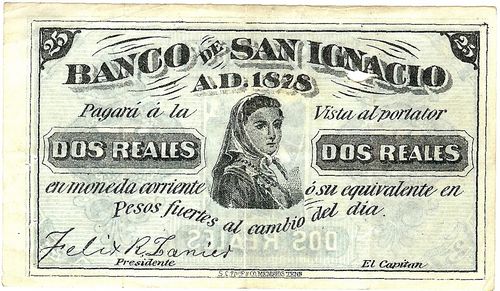
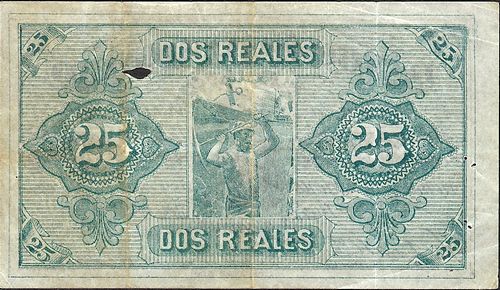 M503 2r Banco de San Ignacio
M503 2r Banco de San Ignacio
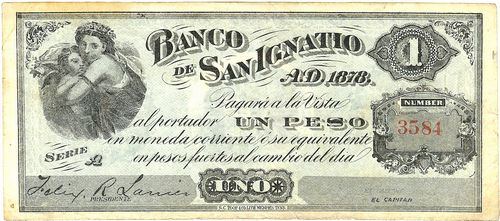
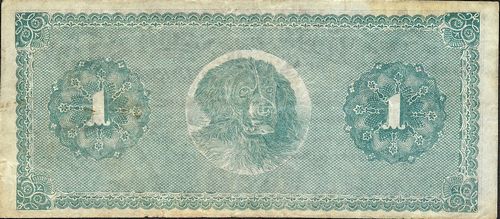 M504 $1 Banco de San Ignacio
M504 $1 Banco de San Ignacio
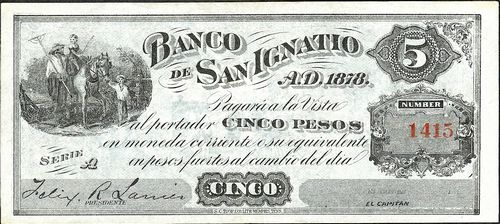
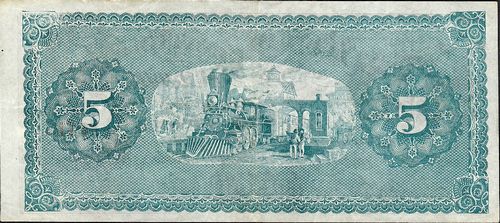 M505 $5 Banco de San Ignacio
M505 $5 Banco de San Ignacio
| series | to | from | total number |
total value |
||
| 25c | ||||||
| $1 | A | includes numbers 701 to 3584 | ||||
| $5 | A | includes numbers 401 to 1483CNBanxico #301 |
Similar to the Guadalupe y Calvo notes are the notes of the enigmatic Banco de San Ignacio. Elizabeth Barrett Browning once asked Robert Browning what he meant by a line in his poem Sordello. He replied, ‘When I wrote that only God and myself knew what I meant. Now only He knows.’ In a similar vein I once asked Duane Douglas why, when he catalogued the Nicanor Vega collection, he had included the Banco de San Ignacio amongst Chihuahua, but in his Complete Encyclopedia of Mexican Paper Money placed it in Sinaloa. He gave me almost the same reply.
El Banco de San Ignacio does not appear to have been a true bank, authorised either by a state or the federal legislature, but if a bank at all, it would have been a private one akin to the Banco de Patricio Milmo of Nuevo León. However, the title 'Banco' might have been to establish confidence and suggest creditworthiness and the notes appear to belong among those issued by mining companies. If so, they must come from an area that in the 1870s was enjoying a sufficiently robust economy to need such a medium of exchange, and so again one can certainly expect them to come from one of the northern states.
The notes themselves offer some clues. Like the Guadelupe y Calvo Mining Company notes, they are dated 1878, were printed in the United States by S. C. Toof and Co. Lithographers of Memphis, Tenneseenow Starr-Toof Printing, 670 S Cooper Street, Memphis, TN 38104 (901-274-3632), and so will also have been issued by an American mining company incorporated in Tennessee (as was the Guadelupe y Calvo company). They have the printed signature of Felix R. Lanier as President, for whom this seems to be a side interest, and have a space for countersigning by the Overseer (Capitan).
|
[if correct person] Felix R. Lanier was born in Nashville, Tennessee, in May 1829, the son of F. R. Lanier, a successful landowner. Felix “was favored with exceptionally fine educational advantages, which he improved to the utmost extent, and after attending the common schools of Nashville he went to school at Randolph, and also to the Mountain Academy at Covington, Tenn., becoming thereby well equipped to fight his own way in the world. At the age of twenty years he went to Brownsport, Tenn., and built what was known as Brownsport Furnace, it being the first hot-blast furnace built in the State, and was for many years one of the largest furnaces in the State. After managing this successfully for about four years he sold out, and moved back to the plantation, on which he remained until the breaking out of the war between the States. In 1861 he was elected to represent the people of Mississippi County in the convention that passed the ordinance of secession, which convened the 4th of March, 1861, and in which the State was withdrawn from the Union, and Mr. Lanier signed his name to this ordinance. Only two copies are in existence, one of which he has in his possession, and keeps in a safe in Memphis. In company with the late Dr. Luke P. Blackburn, who was afterward governor of Kentucky, he volunteered as aid on the staff of Gen. Sterling Price, and it was but a short time until he was appointed inspector of mines and furnaces for the Confederate States, which position he held until he was captured at Selma, Ala., in April, 1865, by Gen. Wilson, from whom he succeeded in making his escape. He then, after the surrender of the Southern army, made his way home, which he reached without any means whatsoever with which to improve his farm and clear it of debt, it having become badly involved for security debts. He settled in Memphis, and engaged in the real estate business, in partnership with Mr. Monsarratt and Maj. R. C. Wintersmith, the firm taking the name of Monsarratt, Lanier & Co. They did exceptionally well in this business for a few years, then Mr. Lanier embarked in the oíl industry, establishing the Bluff City Oíl Company, the oíl being manufactured from the cotton seed. He remained in this business until he acquired sufficient means with which to clear his farm from debt - it being involved to the extent of $75,000 - and in 1885 settled on the old homestead, which he commenced to put in tillable shape once more, it having grown up to brush and wood during his absence. Since returning he has cleared about 300 acres in the home place and 130 acres in a farm adjacent. He employs about 100 people on his plantations. In 1882 he made a trip to Europe, in the interest of the cotton-seed oíl business, and visited all the principal cities of Great Britain - Glasgow, Liverpool, London, Manchester, Leeds, Hull, on the North Sea, and took a pleasure trip to Paris. He investigated many of the cotton-seed oíl-mills of the old world, and says that they make much more oíl in Europe than they do in the United States, although they get the most of their seed from this country, Egypt and India. In 1855 he was married to Miss Martha Norvell, a daughter of Moses Norvell, a merchant of Nashville, Tenn., who died there the year before his daughter's marriage, followed by his wife a few years later. Mrs. Lanier died in Memphis, Tenn., in 1885, never having borne any children. Mrs. Lanier, the mother of our subject, died in 1884, at her son's home in Memphis. Mr. Lanier has always been active in politics, and is a Democrat in his views. He also belongs to the I. O. O. F., and for many years has been a member of the Episcopal Church"Biographical and Historical Memoirs of Mississippi County, Arkansas,1889. He died on 23 October 1907 in Nashville, Tennessee |
 |
:
Like the Guadelupe y Calvo notes, the Banco de San Ignacio notes are known in three denominations: two reales, one peso and five pesos.
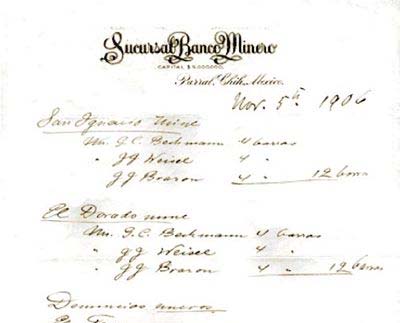
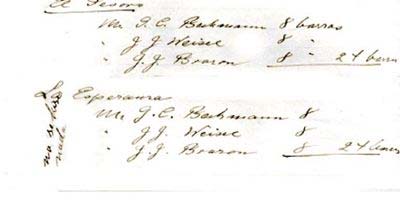
Ramón Lerna Alvidrez has drawn attention to the above document which shows that in November 1906 the Parral branch of the Banco Minero was handling twelve bars of silver from the San Ignacio Mine. The three people assigned (or responsible for) four bars each - Guillermo C. Beckmann, Juan J. Weisell (of Juan J. Weisel y Kock) and J. J. Branon - appear to have been commission agents.
As yet these notes have not been definitely located. Although there are several San Ignacios in Chihuahua, there are also several in Sonora and it is the name of the main mining district in Sinaloa, but, based on the Banco Minero letter, the main contender appears to be San Ignacio de la Sierra in the municipio of Tepeguanes (Tepehuanes) in the state of DurangoTepehuanes is located in the north west of Durango and bounds, to the north, with Guanacevi; to the east, with El Oro, to the west with Topia and Tamazula, and to the south with Canelas and Santiago Papasquiaro.
